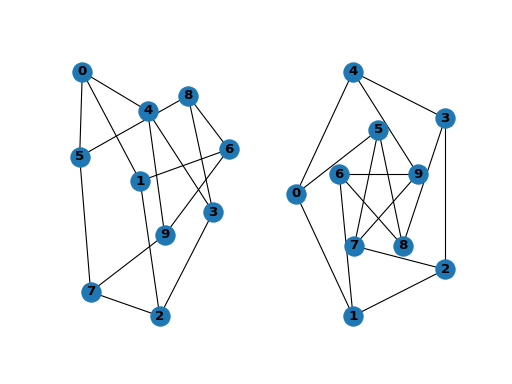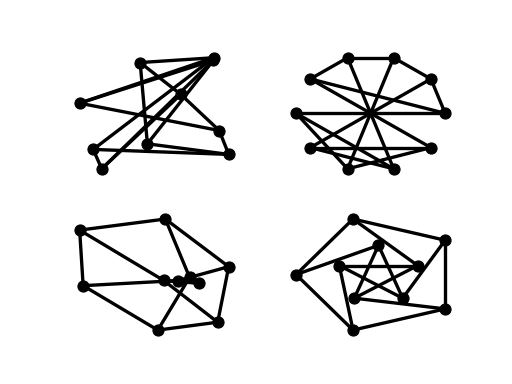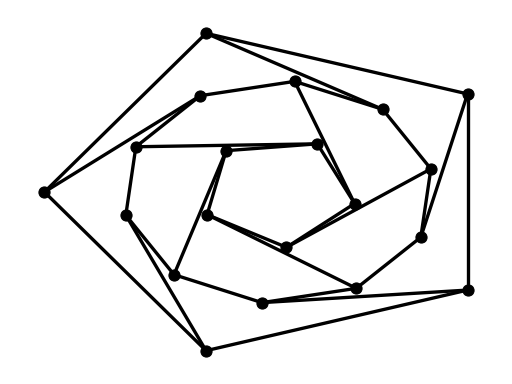Tutorial#
This guide can help you start working with NetworkX.
Creating a graph#
Create an empty graph with no nodes and no edges.
>>> import networkx as nx
>>> G = nx.Graph()
By definition, a Graph is a collection of nodes (vertices) along with
identified pairs of nodes (called edges, links, etc). In NetworkX, nodes can
be any hashable object e.g., a text string, an image, an XML object,
another Graph, a customized node object, etc.
Note
Python’s None object is not allowed to be used as a node. It
determines whether optional function arguments have been assigned in many
functions.
Nodes#
The graph G can be grown in several ways. NetworkX includes many
graph generator functions and
facilities to read and write graphs in many formats.
To get started though we’ll look at simple manipulations. You can add one node
at a time,
>>> G.add_node(1)
or add nodes from any iterable container, such as a list
>>> G.add_nodes_from([2, 3])
You can also add nodes along with node
attributes if your container yields 2-tuples of the form
(node, node_attribute_dict):
>>> G.add_nodes_from([
... (4, {"color": "red"}),
... (5, {"color": "green"}),
... ])
Node attributes are discussed further below.
Nodes from one graph can be incorporated into another:
>>> H = nx.path_graph(10)
>>> G.add_nodes_from(H)
G now contains the nodes of H as nodes of G.
In contrast, you could use the graph H as a node in G.
>>> G.add_node(H)
The graph G now contains H as a node. This flexibility is very powerful as
it allows graphs of graphs, graphs of files, graphs of functions and much more.
It is worth thinking about how to structure your application so that the nodes
are useful entities. Of course you can always use a unique identifier in G
and have a separate dictionary keyed by identifier to the node information if
you prefer.
Note
You should not change the node object if the hash depends on its contents.
Edges#
G can also be grown by adding one edge at a time,
>>> G.add_edge(1, 2)
>>> e = (2, 3)
>>> G.add_edge(*e) # unpack edge tuple*
by adding a list of edges,
>>> G.add_edges_from([(1, 2), (1, 3)])
or by adding any ebunch of edges. An ebunch is any iterable
container of edge-tuples. An edge-tuple can be a 2-tuple of nodes or a 3-tuple
with 2 nodes followed by an edge attribute dictionary, e.g.,
(2, 3, {'weight': 3.1415}). Edge attributes are discussed further
below.
>>> G.add_edges_from(H.edges)
There are no complaints when adding existing nodes or edges. For example, after removing all nodes and edges,
>>> G.clear()
we add new nodes/edges and NetworkX quietly ignores any that are already present.
>>> G.add_edges_from([(1, 2), (1, 3)])
>>> G.add_node(1)
>>> G.add_edge(1, 2)
>>> G.add_node("spam") # adds node "spam"
>>> G.add_nodes_from("spam") # adds 4 nodes: 's', 'p', 'a', 'm'
>>> G.add_edge(3, 'm')
At this stage the graph G consists of 8 nodes and 3 edges, as can be seen by:
>>> G.number_of_nodes()
8
>>> G.number_of_edges()
3
Note
The order of adjacency reporting (e.g., G.adj,
G.successors,
G.predecessors) is the order of
edge addition. However, the order of G.edges is the order of the adjacencies
which includes both the order of the nodes and each
node’s adjacencies. See example below:
>>> DG = nx.DiGraph()
>>> DG.add_edge(2, 1) # adds the nodes in order 2, 1
>>> DG.add_edge(1, 3)
>>> DG.add_edge(2, 4)
>>> DG.add_edge(1, 2)
>>> assert list(DG.successors(2)) == [1, 4]
>>> assert list(DG.edges) == [(2, 1), (2, 4), (1, 3), (1, 2)]
Examining elements of a graph#
We can examine the nodes and edges. Four basic graph properties facilitate
reporting: G.nodes, G.edges, G.adj and G.degree. These
are set-like views of the nodes, edges, neighbors (adjacencies), and degrees
of nodes in a graph. They offer a continually updated read-only view into
the graph structure. They are also dict-like in that you can look up node
and edge data attributes via the views and iterate with data attributes
using methods .items(), .data().
If you want a specific container type instead of a view, you can specify one.
Here we use lists, though sets, dicts, tuples and other containers may be
better in other contexts.
>>> list(G.nodes)
[1, 2, 3, 'spam', 's', 'p', 'a', 'm']
>>> list(G.edges)
[(1, 2), (1, 3), (3, 'm')]
>>> list(G.adj[1]) # or list(G.neighbors(1))
[2, 3]
>>> G.degree[1] # the number of edges incident to 1
2
One can specify to report the edges and degree from a subset of all nodes
using an nbunch. An nbunch is any of: None (meaning all nodes),
a node, or an iterable container of nodes that is not itself a node in the
graph.
>>> G.edges([2, 'm'])
EdgeDataView([(2, 1), ('m', 3)])
>>> G.degree([2, 3])
DegreeView({2: 1, 3: 2})
Removing elements from a graph#
One can remove nodes and edges from the graph in a similar fashion to adding.
Use methods
Graph.remove_node(),
Graph.remove_nodes_from(),
Graph.remove_edge()
and
Graph.remove_edges_from(), e.g.
>>> G.remove_node(2)
>>> G.remove_nodes_from("spam")
>>> list(G.nodes)
[1, 3, 'spam']
>>> G.remove_edge(1, 3)
Using the graph constructors#
Graph objects do not have to be built up incrementally - data specifying graph structure can be passed directly to the constructors of the various graph classes. When creating a graph structure by instantiating one of the graph classes you can specify data in several formats.
>>> G.add_edge(1, 2)
>>> H = nx.DiGraph(G) # create a DiGraph using the connections from G
>>> list(H.edges())
[(1, 2), (2, 1)]
>>> edgelist = [(0, 1), (1, 2), (2, 3)]
>>> H = nx.Graph(edgelist) # create a graph from an edge list
>>> list(H.edges())
[(0, 1), (1, 2), (2, 3)]
>>> adjacency_dict = {0: (1, 2), 1: (0, 2), 2: (0, 1)}
>>> H = nx.Graph(adjacency_dict) # create a Graph dict mapping nodes to nbrs
>>> list(H.edges())
[(0, 1), (0, 2), (1, 2)]
What to use as nodes and edges#
You might notice that nodes and edges are not specified as NetworkX
objects. This leaves you free to use meaningful items as nodes and
edges. The most common choices are numbers or strings, but a node can
be any hashable object (except None), and an edge can be associated
with any object x using G.add_edge(n1, n2, object=x).
As an example, n1 and n2 could be protein objects from the RCSB Protein
Data Bank, and x could refer to an XML record of publications detailing
experimental observations of their interaction.
We have found this power quite useful, but its abuse
can lead to surprising behavior unless one is familiar with Python.
If in doubt, consider using convert_node_labels_to_integers() to obtain
a more traditional graph with integer labels.
Accessing edges and neighbors#
In addition to the views Graph.edges, and Graph.adj,
access to edges and neighbors is possible using subscript notation.
>>> G = nx.Graph([(1, 2, {"color": "yellow"})])
>>> G[1] # same as G.adj[1]
AtlasView({2: {'color': 'yellow'}})
>>> G[1][2]
{'color': 'yellow'}
>>> G.edges[1, 2]
{'color': 'yellow'}
You can get/set the attributes of an edge using subscript notation if the edge already exists.
>>> G.add_edge(1, 3)
>>> G[1][3]['color'] = "blue"
>>> G.edges[1, 2]['color'] = "red"
>>> G.edges[1, 2]
{'color': 'red'}
Fast examination of all (node, adjacency) pairs is achieved using
G.adjacency(), or G.adj.items().
Note that for undirected graphs, adjacency iteration sees each edge twice.
>>> FG = nx.Graph()
>>> FG.add_weighted_edges_from([(1, 2, 0.125), (1, 3, 0.75), (2, 4, 1.2), (3, 4, 0.375)])
>>> for n, nbrs in FG.adj.items():
... for nbr, eattr in nbrs.items():
... wt = eattr['weight']
... if wt < 0.5: print(f"({n}, {nbr}, {wt:.3})")
(1, 2, 0.125)
(2, 1, 0.125)
(3, 4, 0.375)
(4, 3, 0.375)
Convenient access to all edges is achieved with the edges property.
>>> for (u, v, wt) in FG.edges.data('weight'):
... if wt < 0.5:
... print(f"({u}, {v}, {wt:.3})")
(1, 2, 0.125)
(3, 4, 0.375)
Adding attributes to graphs, nodes, and edges#
Attributes such as weights, labels, colors, or whatever Python object you like, can be attached to graphs, nodes, or edges.
Each graph, node, and edge can hold key/value attribute pairs in an associated
attribute dictionary (the keys must be hashable). By default these are empty,
but attributes can be added or changed using add_edge, add_node or direct
manipulation of the attribute dictionaries named G.graph, G.nodes, and
G.edges for a graph G.
Graph attributes#
Assign graph attributes when creating a new graph
>>> G = nx.Graph(day="Friday")
>>> G.graph
{'day': 'Friday'}
Or you can modify attributes later
>>> G.graph['day'] = "Monday"
>>> G.graph
{'day': 'Monday'}
Node attributes#
Add node attributes using add_node(), add_nodes_from(), or G.nodes
>>> G.add_node(1, time='5pm')
>>> G.add_nodes_from([3], time='2pm')
>>> G.nodes[1]
{'time': '5pm'}
>>> G.nodes[1]['room'] = 714
>>> G.nodes.data()
NodeDataView({1: {'time': '5pm', 'room': 714}, 3: {'time': '2pm'}})
Note that adding a node to G.nodes does not add it to the graph, use
G.add_node() to add new nodes. Similarly for edges.
Edge Attributes#
Add/change edge attributes using add_edge(), add_edges_from(),
or subscript notation.
>>> G.add_edge(1, 2, weight=4.7 )
>>> G.add_edges_from([(3, 4), (4, 5)], color='red')
>>> G.add_edges_from([(1, 2, {'color': 'blue'}), (2, 3, {'weight': 8})])
>>> G[1][2]['weight'] = 4.7
>>> G.edges[3, 4]['weight'] = 4.2
The special attribute weight should be numeric as it is used by
algorithms requiring weighted edges.
Directed graphs#
The DiGraph class provides additional methods and properties specific
to directed edges, e.g.,
DiGraph.out_edges, DiGraph.in_degree,
DiGraph.predecessors, DiGraph.successors etc.
To allow algorithms to work with both classes easily, the directed versions of
neighbors is equivalent to
successors while degree reports the sum
of in_degree and out_degree even though that may feel inconsistent at times.
>>> DG = nx.DiGraph()
>>> DG.add_weighted_edges_from([(1, 2, 0.5), (3, 1, 0.75)])
>>> DG.out_degree(1, weight='weight')
0.5
>>> DG.degree(1, weight='weight')
1.25
>>> list(DG.successors(1))
[2]
>>> list(DG.neighbors(1))
[2]
Some algorithms work only for directed graphs and others are not well
defined for directed graphs. Indeed the tendency to lump directed
and undirected graphs together is dangerous. If you want to treat
a directed graph as undirected for some measurement you should probably
convert it using Graph.to_undirected() or with
>>> H = nx.Graph(G) # create an undirected graph H from a directed graph G
Multigraphs#
NetworkX provides classes for graphs which allow multiple edges
between any pair of nodes. The MultiGraph and
MultiDiGraph
classes allow you to add the same edge twice, possibly with different
edge data. This can be powerful for some applications, but many
algorithms are not well defined on such graphs.
Where results are well defined,
e.g., MultiGraph.degree() we provide the function. Otherwise you
should convert to a standard graph in a way that makes the measurement
well defined.
>>> MG = nx.MultiGraph()
>>> MG.add_weighted_edges_from([(1, 2, 0.5), (1, 2, 0.75), (2, 3, 0.5)])
>>> dict(MG.degree(weight='weight'))
{1: 1.25, 2: 1.75, 3: 0.5}
>>> GG = nx.Graph()
>>> for n, nbrs in MG.adjacency():
... for nbr, edict in nbrs.items():
... minvalue = min([d['weight'] for d in edict.values()])
... GG.add_edge(n, nbr, weight = minvalue)
...
>>> nx.shortest_path(GG, 1, 3)
[1, 2, 3]
Graph generators and graph operations#
In addition to constructing graphs node-by-node or edge-by-edge, they can also be generated by
1. Applying classic graph operations, such as:#
|
Returns the subgraph induced on nodes in nbunch. |
|
Combine graphs G and H. |
|
Combine graphs G and H. |
|
Returns the Cartesian product of G and H. |
|
Compose graph G with H by combining nodes and edges into a single graph. |
|
Returns the graph complement of G. |
|
Returns a copy of the graph G with all of the edges removed. |
|
Returns an undirected view of the graph |
|
Returns a directed view of the graph |
2. Using a call to one of the classic small graphs, e.g.,#
|
Returns the Petersen graph. |
|
Returns the Tutte graph. |
|
Return a small maze with a cycle. |
|
Returns the 3-regular Platonic Tetrahedral graph. |
3. Using a (constructive) generator for a classic graph, e.g.,#
|
Return the complete graph |
|
Returns the complete bipartite graph |
|
Returns the Barbell Graph: two complete graphs connected by a path. |
|
Returns the Lollipop Graph; |
like so:
>>> K_5 = nx.complete_graph(5)
>>> K_3_5 = nx.complete_bipartite_graph(3, 5)
>>> barbell = nx.barbell_graph(10, 10)
>>> lollipop = nx.lollipop_graph(10, 20)
4. Using a stochastic graph generator, e.g,#
|
Returns a |
|
Returns a Watts–Strogatz small-world graph. |
|
Returns a random graph using Barabási–Albert preferential attachment |
|
Returns a random lobster graph. |
like so:
>>> er = nx.erdos_renyi_graph(100, 0.15)
>>> ws = nx.watts_strogatz_graph(30, 3, 0.1)
>>> ba = nx.barabasi_albert_graph(100, 5)
>>> red = nx.random_lobster(100, 0.9, 0.9)
5. Reading a graph stored in a file using common graph formats#
NetworkX supports many popular formats, such as edge lists, adjacency lists, GML, GraphML, LEDA and others.
>>> nx.write_gml(red, "path.to.file")
>>> mygraph = nx.read_gml("path.to.file")
For details on graph formats see Reading and writing graphs and for graph generator functions see Graph generators
Analyzing graphs#
The structure of G can be analyzed using various graph-theoretic
functions such as:
>>> G = nx.Graph()
>>> G.add_edges_from([(1, 2), (1, 3)])
>>> G.add_node("spam") # adds node "spam"
>>> list(nx.connected_components(G))
[{1, 2, 3}, {'spam'}]
>>> sorted(d for n, d in G.degree())
[0, 1, 1, 2]
>>> nx.clustering(G)
{1: 0, 2: 0, 3: 0, 'spam': 0}
Some functions with large output iterate over (node, value) 2-tuples.
These are easily stored in a dict structure if you desire.
>>> sp = dict(nx.all_pairs_shortest_path(G))
>>> sp[3]
{3: [3], 1: [3, 1], 2: [3, 1, 2]}
See Algorithms for details on graph algorithms supported.
Drawing graphs#
NetworkX is not primarily a graph drawing package but basic drawing with Matplotlib as well as an interface to use the open source Graphviz software package are included. These are part of the networkx.drawing module and will be imported if possible.
First import Matplotlib’s plot interface (pylab works too)
>>> import matplotlib.pyplot as plt
To test if the import of nx_pylab was successful draw G
using one of
>>> G = nx.petersen_graph()
>>> subax1 = plt.subplot(121)
>>> nx.draw(G, with_labels=True, font_weight='bold')
>>> subax2 = plt.subplot(122)
>>> nx.draw_shell(G, nlist=[range(5, 10), range(5)], with_labels=True, font_weight='bold')

when drawing to an interactive display. Note that you may need to issue a Matplotlib
>>> plt.show()
command if you are not using matplotlib in interactive mode.
>>> options = {
... 'node_color': 'black',
... 'node_size': 100,
... 'width': 3,
... }
>>> subax1 = plt.subplot(221)
>>> nx.draw_random(G, **options)
>>> subax2 = plt.subplot(222)
>>> nx.draw_circular(G, **options)
>>> subax3 = plt.subplot(223)
>>> nx.draw_spectral(G, **options)
>>> subax4 = plt.subplot(224)
>>> nx.draw_shell(G, nlist=[range(5,10), range(5)], **options)

You can find additional options via draw_networkx() and
layouts via the layout module.
You can use multiple shells with draw_shell().
>>> G = nx.dodecahedral_graph()
>>> shells = [[2, 3, 4, 5, 6], [8, 1, 0, 19, 18, 17, 16, 15, 14, 7], [9, 10, 11, 12, 13]]
>>> nx.draw_shell(G, nlist=shells, **options)

To save drawings to a file, use, for example
>>> nx.draw(G)
>>> plt.savefig("path.png")
This function writes to the file path.png in the local directory. If Graphviz and
PyGraphviz or pydot, are available on your system, you can also use
networkx.drawing.nx_agraph.graphviz_layout or
networkx.drawing.nx_pydot.graphviz_layout to get the node positions, or write
the graph in dot format for further processing.
>>> from networkx.drawing.nx_pydot import write_dot
>>> pos = nx.nx_agraph.graphviz_layout(G)
>>> nx.draw(G, pos=pos)
>>> write_dot(G, 'file.dot')
See Drawing for additional details.
NX-Guides#
If you are interested in learning more about NetworkX, graph theory and network analysis then you should check out nx-guides. There you can find tutorials, real-world applications and in-depth examinations of graphs and network algorithms. All the material is official and was developed and curated by the NetworkX community.